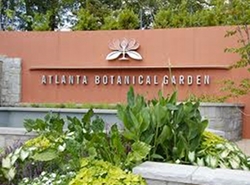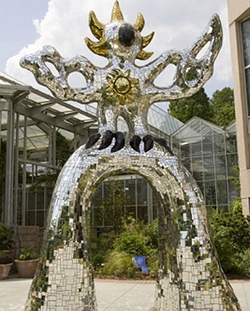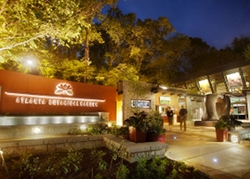by John McGee — 
Introduction
This case study of the Atlanta Botanical Garden (“Garden) is written for Facility Managers who are looking for:

- A best-in-class example that demonstrates how a Sustainability Plan can advance the mission of an institution
- A program that has institutionalized sustainability by involving staff, volunteers and customers in executing the plan
- A business that considers life-cycle costs over first costs but, at the same time, uses a “pay as you go” philosophy and normal payback period requirements
- An institution that considers all aspects of the Triple Bottom Line — Environmental, Societal and Economic but has successfully emphasized the environmental investments without compromising the economic returns.

The Atlanta Botanical Garden (“Garden”) is a 30-acre botanical garden in Midtown Atlanta, Georgia. Christy Jellets, Facility Manager, for the Atlanta Botanical Gardens emphasizes that, since 1976, the mission of the gardens has had a consistent focus and that is to: “Develop and maintain plant collections for the purposes of display, education, conservation, research and enjoyment1″. Consequently, the Garden is both a ” Botanical Museum ” and a sustainability-learning laboratory.
To advance its mission, the Garden’s Board initiated a multi-phase “Green Expansion Plan.” During the construction phase the plan emphasized five key areas of human and environmental health:
- Sustainable site development
- Water savings
- Energy efficiency
- Materials selection and
- Indoor environmental quality.
Completed in early-2010, the Green Expansion Plan resulted in a new visitor’s center, the building of green roofs, the installation of an underground 100,000-gallon water cistern, the construction of a new pedestrian path, and the planting of a southern seasons garden.
Sustainability Attributes Exhibited by the Green Expansion Plan
The Garden’s Green Expansion Plan has a number of exemplary sustainability attributes, including:
- Strategic Sustainability Performance Plan. The Garden’s Green Expansion Plan placed a strategic emphasis on environmental stewardship.
- Sustainability learning laboratory: A specific focus of the plan was to advance the entire Garden to be a dynamic, living, learning laboratory for sustainability initiatives.
- LEED Certification The Garden made a decision to have its new buildings certified in accordance with the requirements of the LEED (Leadership in Energy and Environmental Design) Green Building Rating System. This system was developed by the U.S. Green Building Council (USGBC) and is based on a variety of categories, including site sustainability, energy, materials, and indoor quality and divides buildings into four categories – basic certification, silver, gold, and platinum.
- Triple Bottom-Line Accountability With the Green Expansion plan, the Garden addressed all three aspects of the Triple Bottom Line – Environmental, Societal and Economic – with the following embedded in the plan:
Environmental
- Environmental stewardship: The plan explicitly promoted environmental stewardship through the safeguarding and effective use of energy, water soil and other natural resources
- Sustainable site development: There was a formal process to ecologically plan and implement all aspects of the site’s development.
- Green space: Green space generally refers to any land area covered with vegetation
- Water conservation: Being a botanical garden, water conservation was particularly emphasized from both the viewpoint of reducing water usage and also increasing the recycling of waste water
- Green roof – The plan was approved for the Garden to invest in green roofs. Such roofs fall into two categories – extensive & intensive: A green roof is one that includes vegetation and a growing medium, planted over a waterproofing membrane. “Extensive” green roofs are virtually self-sustaining and require minimum maintenance “Intensive” green roofs are labor-intensive, requiring irrigation, feeding and other maintenance.
- Heat island effect: This occurs in developed areas where the elimination of natural land cover results in an increase in outdoor temperatures. The plan included actions that aimed to offset any heat island effect by vegetation, the new green roofs, and light colored materials that reflect heat.
- Indoor environmental quality: All actions within the plan considered the relative health of the air in the affected indoor environments.
- Natural ventilation: Where possible, natural ventilation was emphasized and used outside air without the use of a fan or other mechanical system.
- Natural daylight: Also, where possible, natural daylight is being used to improve the “botanical garden experience” and to reduce energy usage in its buildings.
- Recycled/Reuse materials: The plan include a comprehensive and ongoing program to collect, sort, process, convert and reuse discarded materials. This process is often referred to as “cradle to cradle”
- Thermal/shade curtains: The plan also approved the placement of thermal/shade curtains. An energy curtain or screen is an insulating blanket that adds an additional thermal boundary in greenhouses.
Societal
- Green education: A huge emphasis of the plan focused on sustainability education for its members. In particular, educational events were designed to demonstrate how natural ecosystems function and how human beings can best interact with them in order to live in a sustainable manner.
- Zero-trash environment: The plan also encouraged the philosophy of redesigning resource life cycles so that all products are reused and to demonstrate how members can implement similar actions in their home and work environments.
Economic
- Energy Efficiency: Programs and actions were put in place to measuring and analyze energy consumption so as to improve overall energy efficiency.
- Green procurement — products & services: An important element of the plan was the drive to procure environmentally friendly products, services and contractors. This included the embedding of environmental requirements in contracts.
- Lighting study: Studies were approved with the intent to install more energy efficient lighting and resulting in lower electricity usage.
Results from Green Plan Implementation

The results actions were numerous and each of them impressive:
- The expansion enhanced the Garden’s plant offerings while reducing the overall heat island2 effect and increased its sustainability features. For example, the new multi-level parking facility, which the Garden shares with neighboring Piedmont Park , occupies only one acre and allows both the Garden and the park to convert existing parking lots to green space. The plan included constructing new facilities including the new Hardin Visitor Center and a 600-foot-long Canopy Walk.
- The installation of three green roofs: one intensive green roof which contains deep soil (as much as 18″) that allow for shrubs and perennials to grow and create a garden-like landscape; and two extensive green roofs which are shallow and provide just enough soil mix for low growing plants like sedum and native grasses. It is worth noting that the extensive roofs are less expensive to build yet provide most of the benefits of the more intensive design
- A focus on water conservation: a 100,000-gallon capacity cistern was installed underground. The cistern harvests storm water from a seven-acre watershed and provides irrigation for 40% of the new gardens. A rainfall of 1.2 inches is needed to fill it to capacity.
- The installation of nineteen foot doors which are open for nine months during the year and allow for natural ventilation throughout the building and help to claim an energy reduction of 122040 kwh per year — resulting in a savings of $14,644 in 2010
- Recycling granite curbs and reusing materials from the site to preserve the history of the Garden.
- A minimum damage to trees, critical root zones and tree canopies because non-traditional construction practices were used and resulted in the recycling of removed trees into mulch for use on the job-site. However, one tree was transformed into a bench that is now on exhibit at the High Museum of Art.
- A new pedestrian path, linking Piedmont Avenue to the Garden and to Piedmont Park , encourages visitors and staff to walk or cycle.

LEED Gold – Hardin Visitor Center and SAGE Parking Facility
The U.S. Green Building Council (USGBC) 3 awarded its LEED Gold certification to two elements of the project—the SAGE parking facility, built into a steeply sloped hillside, and the Hardin Visitor Center .
The Hardin Visitor Center is a visually impressive, transparent structure filled with natural light. It contains three green roofs that absorb rainfall and provides both sound and thermal insulation. Runoff is eliminated, as the plants absorb rainwater falling on the green roof. The LEED-certified design includes:
- Natural day lighting
- Green roof overhead
- Insulated glass
- Local and sustainable wood,
The plantings that cover nearly 50% of the Hardin Visitor Center roof area provide:
- Natural cooling,
- Sound insulation,
- Additional garden area for visitors,
- New wildlife habitat.
Success Factors
Flat Organization Structure
A significant percentage of the staff report directly to the Executive Director including the directors and managers responsible for marketing, development/institutional advancement, education, human resources, finance, facility operations, conservation and the conservatory. All staff members are encouraged to provide input and opinions on all major actions being considered.
Connecting to Stakeholders – Advancing Members’ Sustainability Efforts
The Garden has an extensive and ongoing program to help its members identify and implement residential sustainability improvements. Employing a plant hotline, answered daily by volunteers, the Garden answers such sustainable questions as “how to build a rain barrel” and “what is the recipe for compost tea?” With over 300,000 visitors a year, the Garden uses stealth4 learning opportunities to not only share its collections of beautiful botanical plants but to educate visitors on how to maintain their own landscapes in an environmentally responsible5 way.
Volunteers
Volunteer participation is critical to the success of the Garden. At present, there are currently over 300 volunteers that work alongside the 97 staff. As volunteers continuously meet with visitors (e.g., talking with visitors during “Breakfast in the Garden”, providing “Discovery Cart” education, etc.), they significantly impact the “visitor’s experience.” Consequently, the Garden supports a comprehensive set of programs to orient, train and guide volunteers including initial and ongoing training, support documentation updates, volunteer staff meetings and newsletters.
Partners
The Garden connects with a number of other organizations to ensure the continuance of its mission, including:
- “Garden To Garden” — a benchmarking initiative with other gardens across the country.
- Membership of the American Public Gardens Association (APGA6). Recent initiatives include a network of Public Garden Facility Managers working on best practices together.
- Participation on the ” Atlanta Cultural Operations Team.” This team is comprised of the operational leaders for a number of local organizations including the Atlanta History Center , The Fernbank Museum of Natural History, the Atlanta Zoo and the Georgia Aquarium. As a team they share best practices and mutually support individual team member initiatives.
Fiscal Responsibility
A comprehensive assessment and due diligence is completed before projects are started that considers life cycle costs and benefits and expected return on investments. The Garden has a philosophy of “pay-as-you-go” so the Green Expansion Plan was completed in phases at a total cost of $55M. All phases were initiated after funds were raised and after a review of costs and projected benefits.
Capital Planning
Board, executives and staff work closely together to plan and execute sustainability projects. The Garden has an established consensus-driven culture so staff and volunteers have the ongoing opportunity to impact future plans via participation during staff focus groups. “Give us feedback” is an important goal of the Garden.
Programs and Practices
The Garden is developing a Green Sustainability Plan with an emphasis on Sustainability practices, including:
- Capital Projects
When capital projects are undertaken, particular consideration is given to incorporating the ability to implement future sustainability projects. For example, the SAGE parking facility was constructed using framing that would accommodate the future deployment of solar panels.
- Energy Efficiency Focus
The Garden has been active in approving and implementing a variety of Energy Efficiency programs, including: an extensive lighting study, deploying lighting sensors as well as a program to deploy solar panels. While the Garden is not energy self-sufficient yet because of the energy requirements of the Conservatory and Orchid Center , it has already implemented energy efficiency initiatives that have had a major positive impact on the reduction of energy costs.
It is noteworthy that Georgia Power has been particularly helpful and generous by providing technical advice and energy credits for approved projects.
Energy efficiency continues to be a major focus with solar projects being the first priority followed by the implementation of lighting upgrades
- Visitors
The Garden requests that visitors take their waste home with them and support the Garden’s efforts to achieve a zero-trash environment. This initiative saved over $7,000 in its first year.
- Employees.
Human Resources Director coaches staff as they plan and execute their environmental stewardship actions. Relevant Garden initiatives include:
- Water conservation through the use of the Garden’s onsite hydro-station. Additionally, employees are encouraged to “bring your own glass” to meetings and other activities. In keeping with its focus to support doing the right things for the environment, this program helps the Garden to avoid using Styrofoam and paper cups
- Disposal of all waste via an on-site compactor
- Employee access to free monthly electronic waste (e-waste) and battery disposal at the Garden which helps reduce landfill waste
- Employee incentives for the use of alternative transportation including monthly employee recognition and participation in raffles for gift cards. Since May 2009, participation in the program has tripled.
- Events and Green Concerts where only recyclable materials are used.
- Outsourced Services
- Sustainability is built into Service Level Agreements and is part of the evaluation for employee performance reviews.
- When contracts are renewed, vendors are required to document their sustainable practices and their plans to achieve additional improvements. These factors are given considerable weight in awarding contracts. Therefore contracts are not driven solely by cost considerations.
- Sustainable practices are incorporated into food preparation, the serving of organic food, the provision of environmentally friendly beverages, composting and the use of recyclable materials (e.g. bamboo plates)

(The Large Bird of Fire on an Arch) – Niki de Saint Phalle
Conclusion
Every aspect of The Atlanta Botanical Gardens is driven by what the Garden calls “Sustainability in Action” which has, as its goal, the achievement of responsible environmental stewardship as well as the realization of energy and water conservation.
The sustainability achieved encompasses not only the Garden and its interaction with visitors, employees and vendors, but also in its interaction with the City of Atlanta and with other local and national cultural institutions.

For Facility Manager’s it is an excellent example of how Sustainability can be embedded in an institution’s mission, strategy, business model, capital plans and maintenance programs and achieve all three aspects of the Triple Bottom Line.
Christy Jellets is quick to encourage existing members to visit often and new and prospective members to take full advantage of the numerous exhibitions, events and classes. And with a justified pride in what the Green Expansion Plan has accomplished, quotes from their web site: “The Green Expansion of the Garden continues with a number of spectacular new gardens and amenities for visitors to enjoy. The Green Expansion: Phase II offers visitors wonderful new features to explore including a delicious Edible Garden, a soaring Canopy Walk, the magnificent Storza Woods, and a sparkling Cascades Garden”.
Appendix: References and Additional Reading
- American Public Gardens Association (APGA)
http://www.publicgardens.org/ - Conserve Georgia
http://www.conservegeorgia.org/ - Georgia Department of Natural Resources — Sustainability Division
http://www.gasustainability.org/ - Environmental Protection Agency — Georgia
http://www.gaepd.org/ - EPA — State and Local Climate and Energy Program
http://www.epa.gov/statelocalclimate/state/partner/index.html - EPA — Southeastern States Air Quality Toolkit
http://www.epa.gov/region4/airqualitytoolkit/index.html - EPA — State Climate Change Mitigation Strategy
http://www.epa.gov/statelocalclimate/state/activities/index.html - Green Roofs
http://en.wikipedia.org/wiki/Green_roof
References
- Botanical Garden website – (http://www.atlantabotanicalgarden.org/about-us/mission-history)
- “An urban heat island (UHI) is a metropolitan area which is significantly warmer than its surrounding rural areas.” — Wikipedia (http://en.wikipedia.org/wiki/Heat_island). Also refer to the IFMA Foundation How-To Landscaping Guide
- U.S. Green Building Council (USGBC) – http://www.usgbc.org/
- Rochelle Schwartz-Bloom, a Duke University – (http://www.news-medical.net/news/2007/09/27/30520.aspx)
- (http://www.ifmafoundation.org/programs/sustain_wp.cfm)
- APGA – http://www.publicgardens.org/